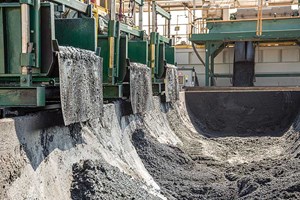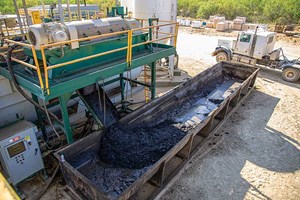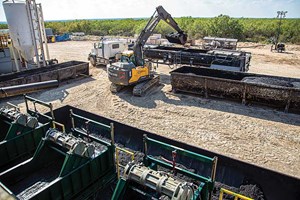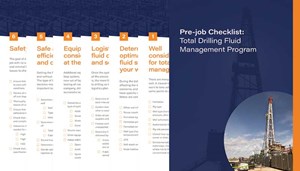Achieving operational efficiency gains using a total fluids management service
It is estimated that drilling fluid costs average 10% of total well construction costs. While this figure may seem like a small percentage, the drilling fluid system connects to almost every other drilling system on the rig. However, unlike other oil and gas rig site systems, the evolving technology around fluids is less understood. Today’s drilling fluid systems can be complicated to manage and employ an equipment mix unique to the wellsite. This includes equipment furnished with the drilling rig alongside additional equipment, (much of it specially sourced) depending on the fluid system, the rig’s drilling system and the formation itself.
Currently, many operators choose different vendors to provide various discrete fluids-related activities:
- Mud selection and on-site operational support
- Equipment selection, including mud tanks, shale shakers, vacuum degasser, desander, desilter, centrifuges and other associated equipment
- Instrumented surface measurements for monitoring the fluid system during drilling operations
- Closed-loop systems for solids control
- Haul-off and disposal services.
MANAGEMENT SERVICES
Because the fluid system touches so many drilling activities, it makes sense that these related processes be managed as an overall system. Today, a total drilling fluids management service is providing benefits for operators, who use this new approach.
A total drilling fluid management service can be defined as a combination of the right equipment, systems and expertise that provides maximum value to the operator in a safe and environmentally sound manner. A total fluid management service includes everything from fluid system selection to solids control and engineering to trucking and disposal services, in addition to onsite operational support.
Drilling today’s complex wells is expensive. While in some cases the cost of a total fluids solutions package may be incrementally more expensive at the start of the project, savings can be realized through reduced equipment footprint and associated costs at the drill site, reduced mud volume used, reduced waste management costs and reduced liability concerns. If taken as a whole, a drilling fluid management program can help operators realize significant savings per well while further enhancing the goal of a successful operation. Engaging a single provider to manage all or just some of these services as a total system can pay dividends to an operator:
- Improve overall well efficiency
- Reduce overall drilling costs
- Extend the life of fluids
- Deliver less NPT
- Improve safety while drilling
- Achieve environmental compliance.
PRE-JOB PLANNING
Regardless if you are planning basic mud and monitoring services or an entire fluid management program, pre-job planning is crucial to the operation. From system design to logistics to equipment hook-up and testing, it is critical to have the right fluid program in place prior to drilling, Fig. 1. The wrong system, incompatible equipment or inexperienced personnel can cause drilling or formation problems that can easily increase overall well costs.
Optimal fluid system. Designing the proper fluid system depends on many variables. The design of the well, depth, formation, length of laterals, type of rig, and overall drilling budget—all contribute to the type and complexity. Other deciding factors include:
- State or local regulations that mandate the use of a closed-loop system.
- Proximity to residential areas
- Environmentally sensitive areas, such as nearby waterways or marshes, where risk to the local environment from a conventional reserve pit is greater.
- Complex setups, such as closed-loop systems, where expertise is needed to manage the overall system.
In addition, the specific mud system will be determined by factors including offset well information; recap reports of nearby wells; the formation and type of well being drilled; the well schematic; and mud types commonly used in the area. The operator also may have specific requirements, such as an oil-based mud, water-based mud, or brine system.

Protecting the environment and adhering to all regulatory controls has made solids control and closed-loop systems a key option during drilling operations. A sound solids control system effectively and efficiently separates the drill cuttings from the drilling fluid and is an integral part of a total drilling fluid management system, Fig. 2. While there are many considerations, including determining the right system, equipment selection, and integration with the drilling rig and drilling program, many benefits can be obtained that result in full system efficiencies.
- Reduce the amount of solids content in the mud
- Reduce disposal, both amount of liquids and solids
- Reduce costs of drilling fluid maintenance, and disposal
- Help achieve environmental and regulatory compliance
- Help lower fluid dilution rates
- Reduce the volume of required additives
- Allow higher flowrates
During drilling, the solids control process must be monitored continuously and tested by the drilling fluids engineer to maintain fluid properties and maintain the optimum system balance between clean fluid and the amount of solids introduced, Fig. 3. If the mud weight changes, the system must be adjusted by fine tuning the centrifuge(s) and adding dilution to remove the optimum amount of cuttings.

An advanced step in solids control is the closed-loop drilling system, where all cuttings and fluids are captured, processed and discharged without the use of any open pits. All cuttings are hauled off and disposed, while fluids are reconditioned, cleaned and processed, then returned to the mud system. This adds an additional step in planning, as trucks need to be on-hand to transport the solids that accumulate during drilling, not after drilling ends. A closed loop system can be utilized with any type of drilling fluid—oil-based, water-based, brine or synthetic; on most any type of rig and for any formation or well type. Using a closed-loop system makes the most sense when:
- A closed-loop system is mandated by the landowner, state or local regulations.
- Drilling on government land.
- Drilling in, or near, a residential area.
- Drilling in, or near, environmentally sensitive areas where risk to the local environment from a conventional reserve pit is greater.
- There is potential for surface water or ground water contamination and associated liabilities.
- Drilling shallow wells, where the cost of building an open pit is not economical.
- Wells are spudded with a water-based mud and then switched to an oil-based mud system.
- Wells utilize an oil-based mud system.
- Offshore operations using a diesel- or mineral-based fluid must include a closed-loop process for continuously capturing all drilled cuttings and returning them to shore for regulated disposal.
A closed-loop drilling system can eliminate or dramatically reduce the use of open pits. Closed loop systems are environmentally sound, can lower overall well construction costs, decrease liabilities from spills and leaks, and decrease regulatory concerns. A closed-loop system enhances the efficiency of the solids control system and can improve drilling operations by helping increase ROP and decreasing fluid loss.
Today, regulatory and environmental concerns have made solids control and closed-loop systems an important part of a total fluids management system. While initial well construction costs can be higher using these systems, there are many benefits that can result in an overall improvement in well economics. In addition, closed-loop systems can minimize and mitigate the risks associated with open pits by eliminating soil and groundwater contamination, and removing the clean-up and remediation costs that may be incurred.
OPERATIONAL EXPERTISE
We have reviewed the many benefits to the operator by using this new, combined fluids management approach. However, the drilling fluids management company must have the actual experience and expertise to make it work. The drilling fluids engineer must have the experience to anticipate what to expect from the formation, foresee what problems may be encountered, and take steps to prevent them from happening. For example, pretreating the mud, based on knowledge of the formation.

A change in mud weight also affects the solids control equipment and system. Screens and centrifuge speeds need to be monitored for optimum solids removal, to run a more cost-effective operation. Screen size may need to be adjusted to remove the maximum volume of cuttings, while allowing fluid through the screens. However, ultra-fine size particles affect mud properties adversely because of their large surface-to-volume ratios. By consulting with the solids control expert, the system can be adjusted to ensure optimum removal of low-gravity solids that can negatively affect the rheological properties of the mud.
The goal is to fine-tune the system to remove the maximum amount of cuttings, recondition the maximum amount of fluid for reuse, and reclaim barite, diesel and other elements with the least dilution possible, Fig. 4. In essence, to keep the fluid system operating at maximum efficiency.
HAUL-OFF/DISPOSAL
The best executed job will be considered a failure, if the fluids and cuttings are not disposed of properly. A total fluid management program includes the haul-off and disposal of all fluids and drill cuttings. Proper haul-off and disposal keeps companies in compliance with governmental regulations. It also avoids the risks of ground and water contamination, improper disposal, and other issues that can linger long after the well enters production.
Disposal options. Safe and efficient disposal of cuttings and fluids is critical to the overall success of the project. The most popular methods of mud and cuttings disposal are land farms and injection. Other methods include biodegradation, incineration and solidification.
The land farm process involves tilling the cuttings and mud into the surrounding soil of a licensed property. Land farming reduces organic and inorganic particles through dilution, biodegradation and absorption. The land farm should be located away from residential, environmental and groundwater areas. During the injection process, cuttings are ground to fine particles, mixed into a slurry, and injected into a well or cavern. The well or cavern must have all proper permits in place, and the local ground water horizons must be avoided.
Transporting the cuttings and liquids to the disposal site involves more than just hiring a qualified trucking company. Location of the nearest disposal site, road conditions and route, the cost of trucking and disposal (and its effect on the overall well construction budget), the type of truck (open, covered or completely sealed) all must be factored in. Regulatory issues, such as permits, manifests and end-of-well reports, are needed, depending on local regulations. And, most importantly, all activities must be performed in a safe and environmentally responsible manner.
CASE STUDY 1
A South Texas operator had a 14-well drilling program in the Eagle Ford shale play. These oil wells included depths down to 11,000 ft, with the horizontal sections ranging from 8,000 to 9,000 ft. Downhole temperatures ranged from 280 to 310°F, and working pressures were from 6,300 to 6,700 psi.
While the previous provider’s performance was satisfactory, the operator was seeking better performance and lower cost for this new program. Panther worked with the operator to devise a plan for the 14 wells, including a solids control program that utilized a combination of an open pit and a closed-loop system, and all haul-off and disposal services.
Increased service quality results in efficiency gains. According to the operator, many individual service quality aspects were enhanced or introduced by Panther Fluids Management. When combined, they created substantial improvements in efficiency that resulted in a highly successful project, compared to previous operations. These included the following topics.
Single-point invoicing. A new single-point invoicing process eliminated time spent by the company man reviewing/questioning each invoice. This resulted in a significant time-savings for the operator, who stated, “This was a load off of me and the operation. Now, we can focus on drilling the well.”
Collaboration. Working with a new vendor means new issues to resolve. The vendor and the operator collaborated on working through problems that arose, with a tighter collaboration compared to previous vendors. The operator stated, “We worked with the solids control expert, who was directly involved with the operations.”
Sound data allowed the operator to stick to the plan. A new daily reporting method allows the operator to compare drilling progress and performance from one day to the next, which was not possible before. “Poor data is useless. The confidence in the data allowed sound engineering decisions at the wellsite and kept the well progressing as planned,” the operator commented.
Solids control kept up with the drilling plan, allowing aggressive drilling rates. The operator stated, “We are known for pushing the envelope on drilling rates, and the solids control system kept up. Drilling rates were 200 ft per hour in the lateral, with no issues.” Fast drilling times allowed the operator to continue the vigorous drilling program uninterrupted.
Professional wellsite staff knew the equipment and the operation, and helped keep the job on schedule. Knowledge of the solids control equipment meant no delays waiting on solids disposal and allowed the operator to keep to the drilling plan. As stated by the operator, “Quality personnel is key to a successful solids control operation. We worked together well. With their expertise in solids control, the system kept the mud clean for optimum performance.”
Haul-off and disposal. The operator did not have to deal with issues of trucking, and the associated paperwork and permitting, which allowed its staff to better focus on drilling the well. A nearby disposal site was selected, and Panther devised the best disposal option per load, compared to previous companies, with a cost per load that fit the drilling budget. The vendor ensured that all site and trucking company permits were in order.
Value delivered. The operator reported that the program was successful, with three wells currently producing, and the others coming on-line soon. “For surface drilling, we were able to batch-drill five wells in four to five days, with each well set at 2,500 ft with no slowdown. We set the remaining wells at 6,000 ft in about a week. We averaged two wells per day on one pad, and one well per day on the other pad.” The operator expects to continue this arrangement on future projects. All wellsite activities were executed safely with no incidents.
CASE STUDY 2
An operator in Colorado County, Texas, had a unique opportunity to directly compare performance on two adjacent, identical wellbores. On the first well, the operator utilized a major fluids company for mud products and separate, smaller vendors for closed loop equipment, disposal and haul-off. For the second well, the operator wanted to lower overall well construction costs and analyzed several options for both mud products and closed loop systems.
The operator selected Panther Fluids Management to provide all-around fluids management, including solids control equipment and personnel, waste haul-off and disposal, and all mud products for the job. The mud engineer from well one was retained for well two. The solids control equipment utilized on the second well was a more complete, robust package, which resulted in higher daily cost for the equipment. By combining the more sophisticated solids control equipment with quality mud products, the operator was able to realize a significant savings in mud costs, due to an overall more efficient operation. Having a single vendor manage the mud and disposal systems was the key advantage for delivering optimal efficiencies and cost-savings for the operator.
CONCLUSION
As the oil and gas industry has grown more complex and competitive, the margin for error has decreased considerably. In addition, regulatory and environmental concerns are now in place that demand more oversight. For example, many states highly recommend the use of closed-loop systems and have enacted stringent regulations on disposal.
The right drilling fluid management system can make the difference between a successful job and one that is fraught with problems, demanding time and resources from the operator. Many operators have found a total fluids management approach allows them to concentrate on drilling the well while the fluids company focuses on mud, solids control and cuttings disposal.

- From injection to insight: Tracing efficiency in surfactant huff and puff (November 2025)
- Maximizing production with smarter lift solutions (November 2025)
- Production technology: How a minor instrument upgrade led to major oil separator savings (November 2025)
- Engineered components are the difference between survival and failure in HPHT subsea systems (November 2025)
- Mature Asset Rejuvenation by Surveillance (MARS): Maximizing value from aging wells (October 2025)
- What's new in production: Be a SWIFTie! (October 2025)
- Subsea technology- Corrosion monitoring: From failure to success (February 2024)
- Applying ultra-deep LWD resistivity technology successfully in a SAGD operation (May 2019)
- Adoption of wireless intelligent completions advances (May 2019)
- Majors double down as takeaway crunch eases (April 2019)
- What’s new in well logging and formation evaluation (April 2019)
- Qualification of a 20,000-psi subsea BOP: A collaborative approach (February 2019)



